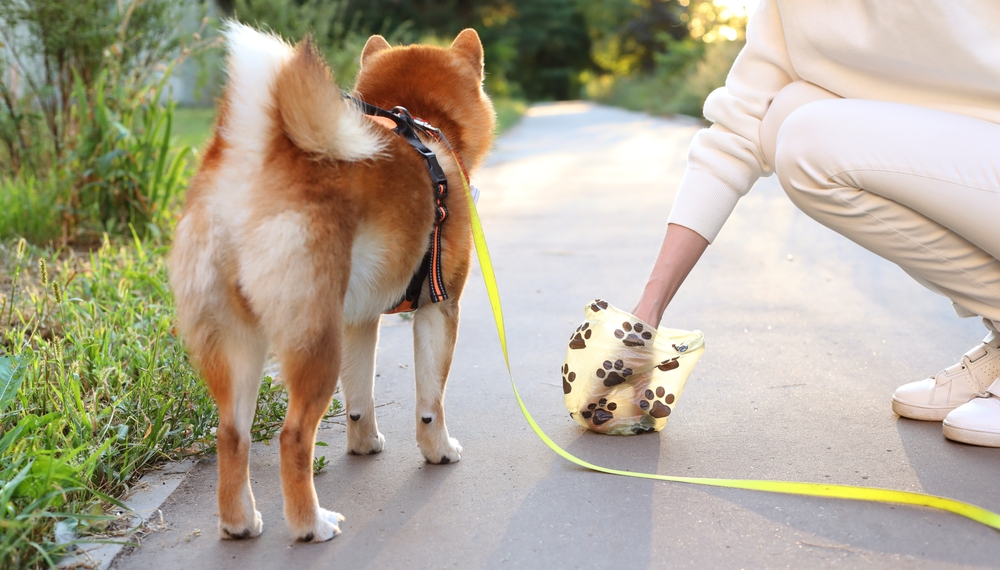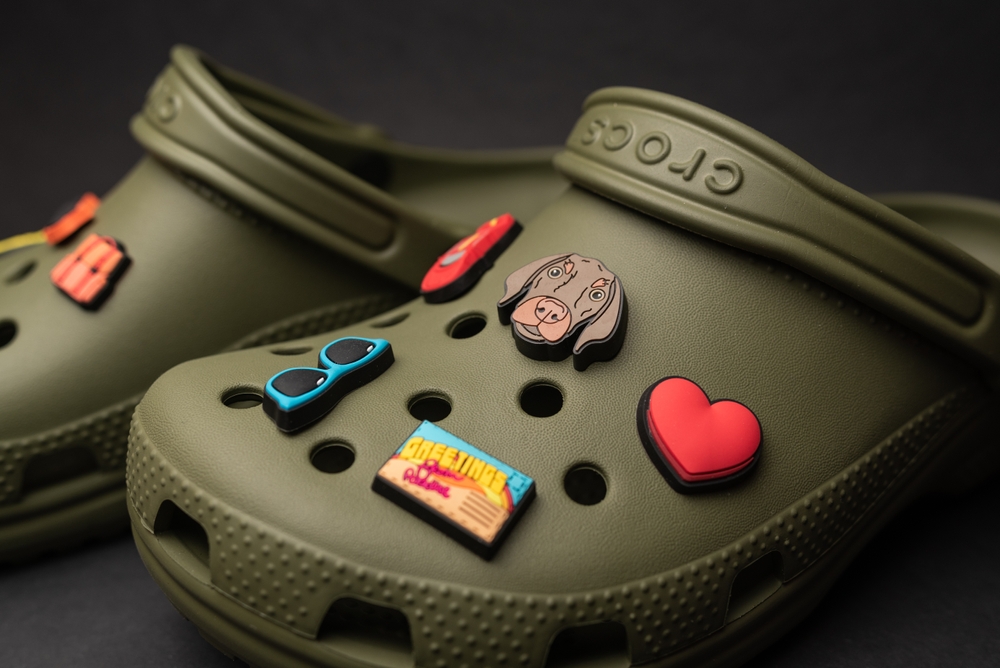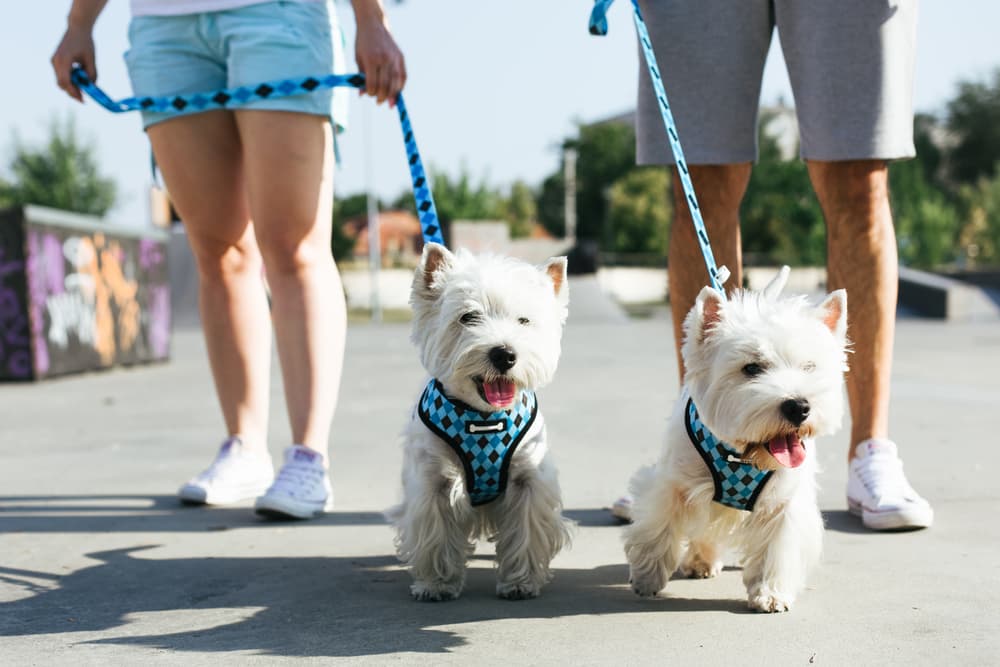Kayaking With a Dog: Tips and 6 Dog-Friendly Kayaks to Consider
Updated on March 04, 2024
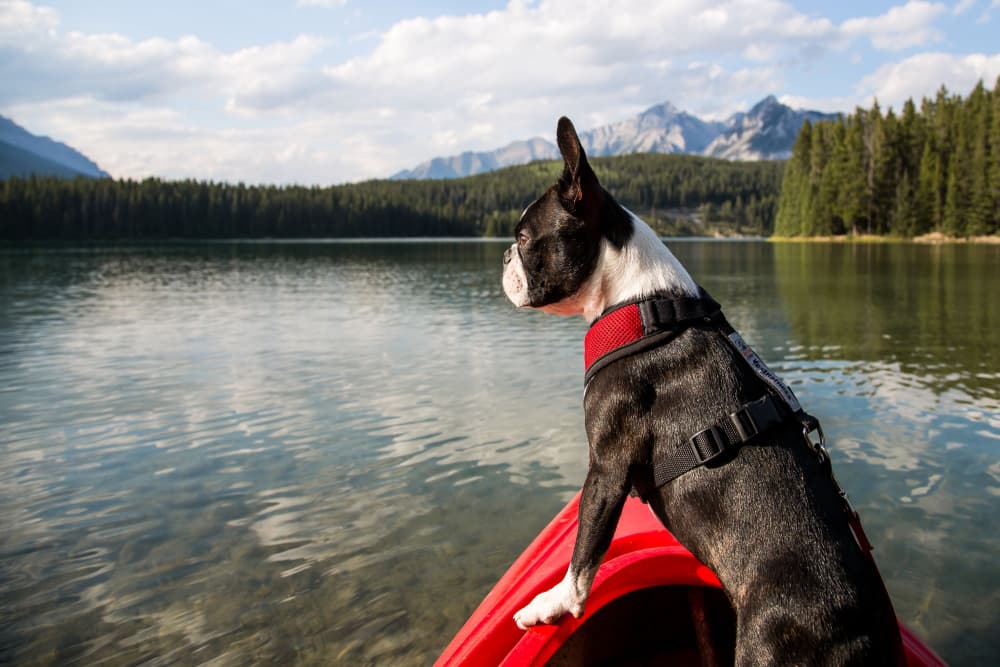
Kayaking is a great way to relax and get exercise out on the water. For many, it’s also an excuse to spend quality time with your pup in nature. But, kayaking with a dog isn’t as simple as putting the canine in the boat and going to the nearest lake or river. It takes patience, training, and the right equipment.
Keep reading for an overview of how to kayak with your dog, advice and tips, and the best dog-friendly kayaks and accessories on the market so you can make this leisure water activity a wonderful and safe experience for you and your dog.
Our Top Dog Friendly Kayak Picks
All featured products are chosen at the discretion of the author. However, Vetstreet may make a small affiliate commission if you click through and make a purchase.
- Best Overall: Ocean Kayak Malibu Two Tandem
- Best Single-Person Kayak: Intex Challenger Kayak
- Best Inflatable Kayak: AdvancedFrame Convertible Tandem Inflatable Kayak
- Best for Beginners: Sea Eagle 330 Deluxe 2 Person Inflatable Sport Kayak
- Best Sit-on-Top Kayak: Lifetime Triton Angler 100 Fishing Kayak
- Most Affordable: Intex Explorer K2 Inflatable Kayak
6 Best Kayaks for Dogs
Here are our top picks for dog friendly kayaks, based on recommendations from expert sources, consumer reviews, ease of use, and price point.
Overall Best Kayak for Dogs
Our Pick: Ocean Kayak Malibu Two Tandem
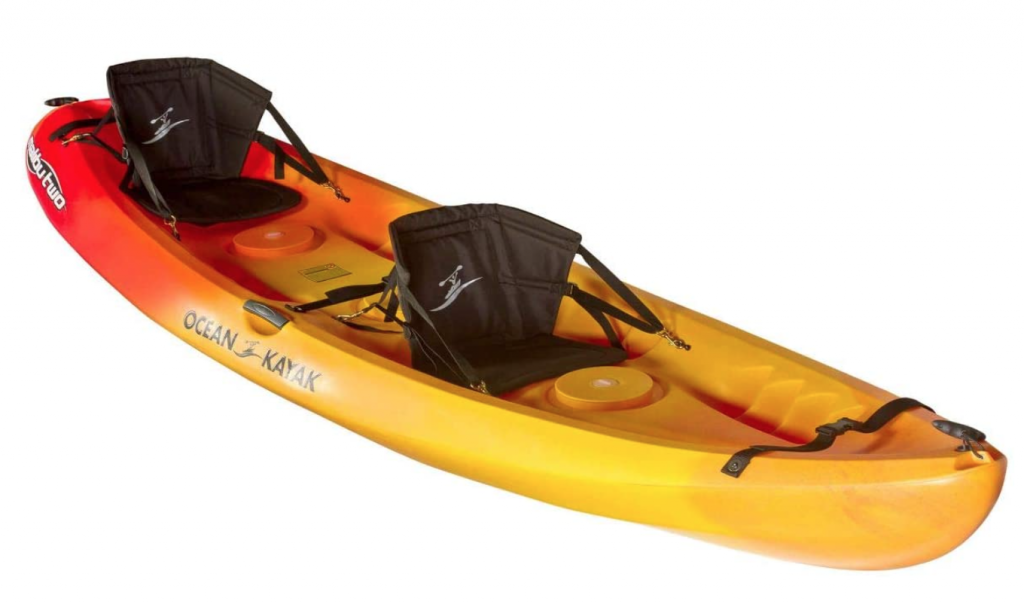
This popular hardshell tandem sit-on-top 12-foot kayak consistently ranks highly among kayakers paddling with dogs, as it remains stable and offers plenty of space. It’s compact and lightweight. Your dog(s) can comfortably lie down in the front while you paddle from the back. It handles calm waters as well as small ocean waves and moderate river currents.
Highlights
- Nice entry-level kayak
- Sit-on-top with a large cockpit space enough for two paddlers and a pet
- Adjustable seats with foam padding
- Center seating area for extra space for dog
- Ability to paddle solo from the back seat
- Tri-hull construction that adds to the stability
- Maximum weight capacity is 362 lbs
- Carrying handles on the side and bow/stern
Things to Consider
- Low capacity for a two person kayak
Best Single Person Kayak for Paddling With Dogs
Our Pick: Intex Challenger Kayak

If you don’t want to be paddling a large kayak, this single-person unit has an inflatable seat with backrest and allows for 220 pounds. The kayak itself weighs 27 pounds and is approved by the U.S. Coast Guard.
Highlights
- Made with 30-gauge durable vinyl and an inflatable I-beam floor for that is both rigid and comfortable
- Two separate air chambers, including a safety auxiliary chamber
- Streamlined design with a cargo net for personal items
- Quick deflation and inflation with Boston valves
- Maximum weight capacity is 325 lbs
- Comes with a repair patch
- Heavy duty puncture resistant
Things to Consider
- Inflatable kayaks may not be preferred by some
- May not be ideal during high winds or strong waves
Best Inflatable Kayak for Dogs
Our Pick: AdvancedFrame Convertible Tandem Inflatable Kayak
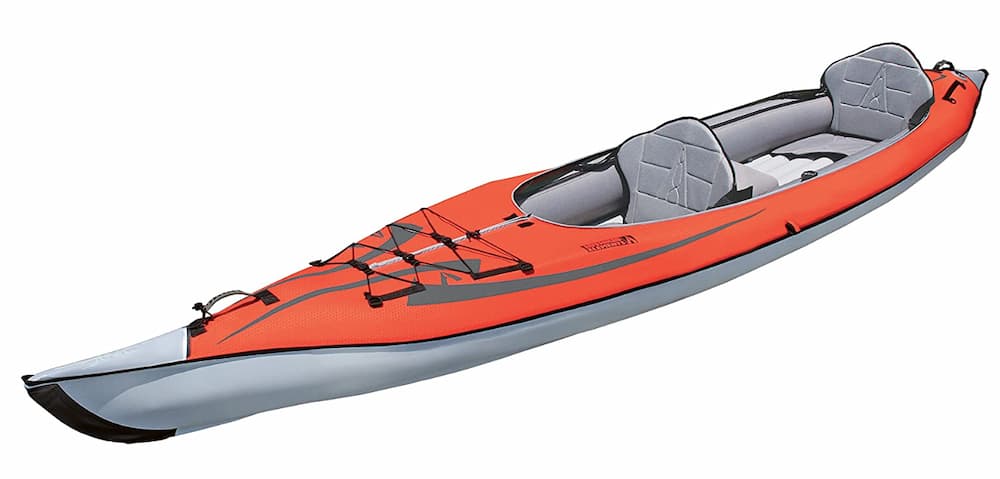
This convertible, inflatable kayak keeps your worries of your dogs’ nails puncturing the craft at bay, thanks to its advanced puncture resistance capabilities. This kayak is roomy enough to fit two people and a large dog comfortably.
Highlights
- Three layers of material
- Plenty of space for everyone, including supplies
- Conversion deck turns sit-on-top kayak into closed hull that can be a dog platform
- Built-in aluminum ribs
- Folds up into its own bag and comes pre-assembled; simply unfold and inflate and attach the seats
- Adjustable padded seats and three seat locations to paddle solo or tandem
- Maximum weight capacity of 550 lbs
Things to Consider
- Carrying case is undersized for the kayak, making packing a bit difficult
- Heavy and may be harder to carry by one person
- Difficult to dry it out
Best Kayak for Beginners
Our Pick: Sea Eagle 330 Deluxe 2 Person Inflatable Sport Kayak
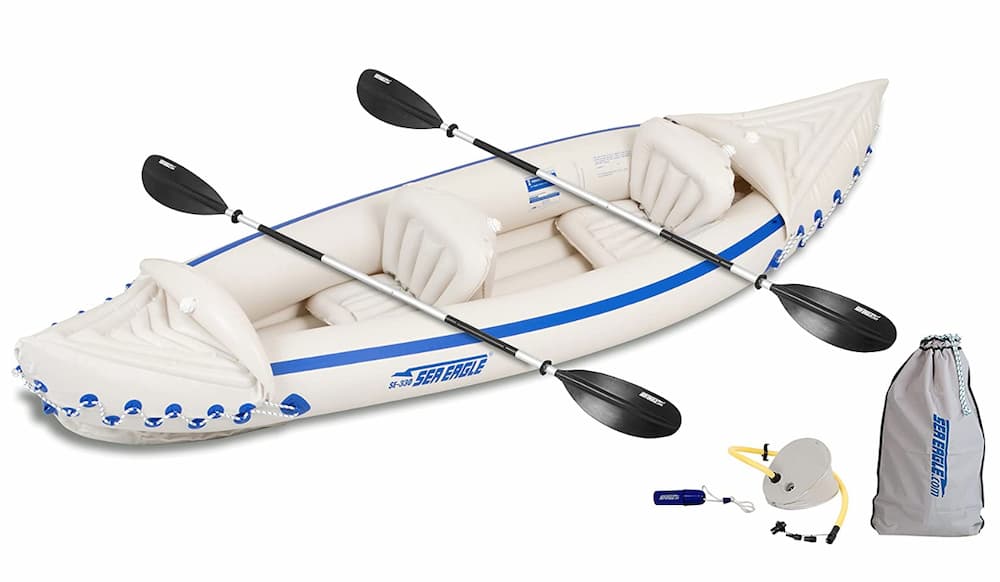
The Sea Eagle 330 Deluxe 2 Person Inflatable Sport Kayak is a good option for new kayakers who want to take their dogs out on the water. It offers stability and space, and it’s lightweight enough for road trips and weekend outings.
Highlights
- Comes with its own air pump and two paddles, a repair kit in the package
- Capacity to carry 500 lbs
- Easy to carry as it only weighs 26 lbs
- Includes two removable inflatable seats
Things to Consider
- Doesn’t do well in rougher waters
Best Sit-On-Top Kayak for Dogs
Our Pick: Lifetime Triton Angler 100 Fishing Kayak
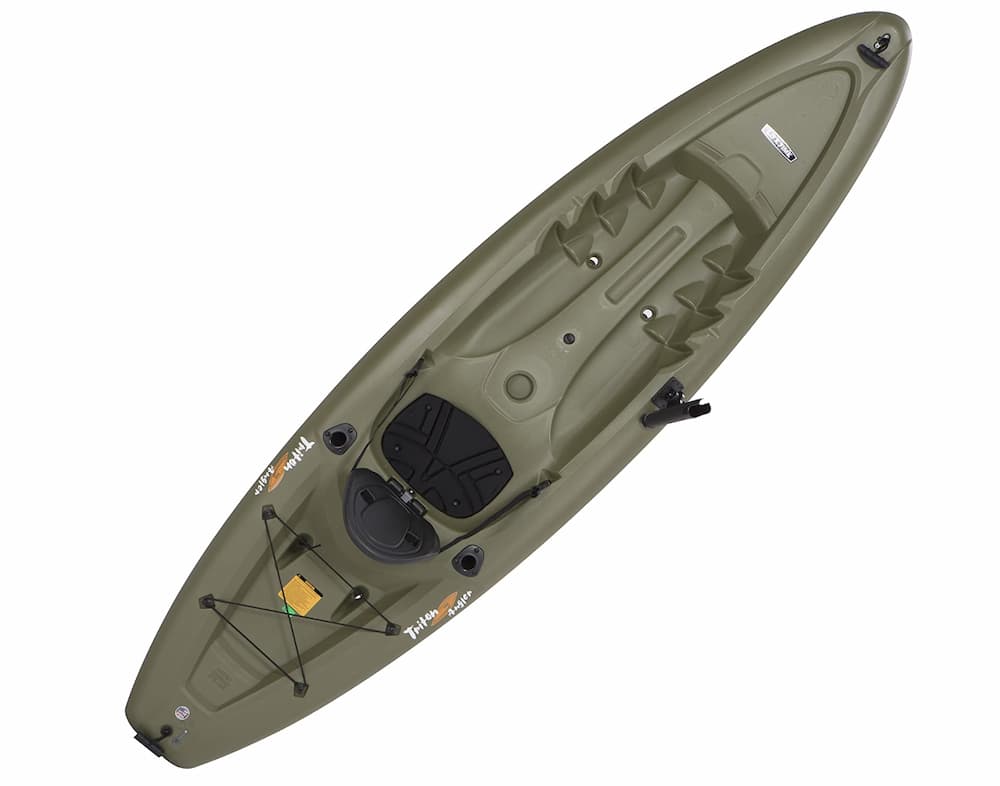
As previously mentioned, fishing kayaks are wider and offer more stability. This hardshell single-person kayak has space on top for you and your pet to sit comfortably.
Highlights
- Front and rear handles to transport easily
- Various footrest positions
- Storage with Bungee cord lacing
- Adjustable quick release seat back
- Weight capacity of 275 lbs
Things to Consider
- Seat could become uncomfortable during prolonged usage
Most Affordable Kayak for Dogs
Our Pick: Intex Explorer K2 Inflatable Kayak
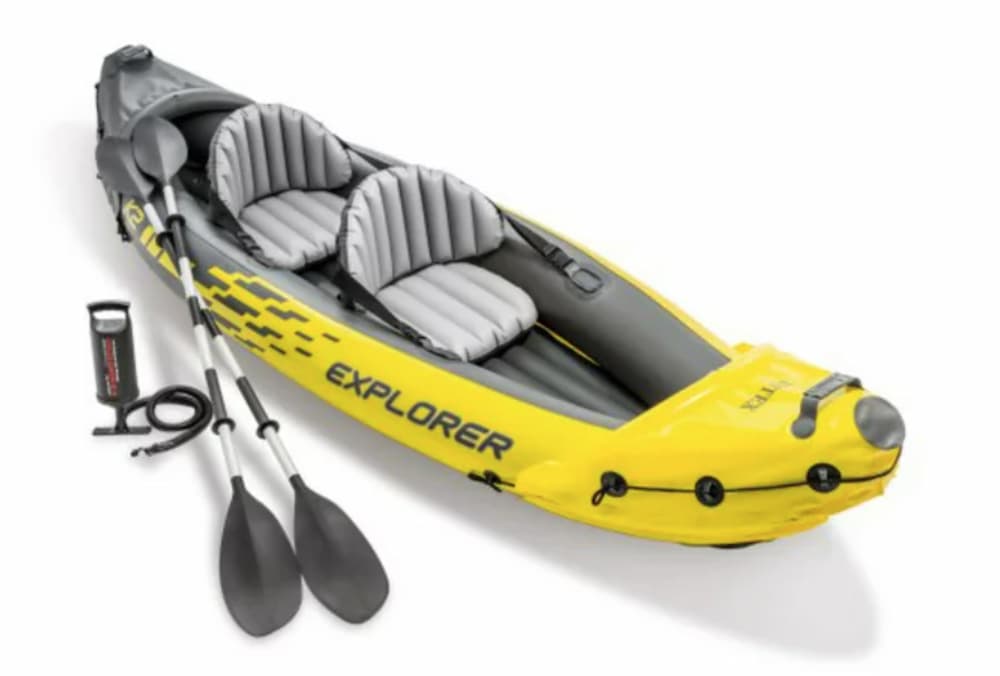
If your budget is limited or you want to try out kayaking with your dog to see if she likes it before investing further, the Intex Explorer K2 two-person kayak is a smart choice. This kayak also gives you the stability of a sit-on-top kayak but with higher sides if you are concerned about your dog sliding on the sides.
Highlights
- Strong vinyl construction
- Weighs only 30 lbs but has a capacity of 400 lbs
- Comes with with a beginner kit, complete with pump, paddles, carry bag, and a detachable skeg
- Extra-wide beam makes it more stable
- Easy to set up
Things to Consider
- Space can get warm on sunny days. Be sure to bring a towel for your furry friend
- No storage space
- Carry bag and pump are of poor quality
Bonus Picks: Must-Have Kayak Accessories for Dogs
See below for accessories and essential items needed for dogs for kayaking.
- Best Dog Life Vest for Kayaking- Non-Stop Dog Wear Protector Life Jacket
- Best Dog Kayak Tow- Intex Explorer Inflatable Boat Series
- Best Dog Kayak Shade- MOOCY Sun Shade Canopy for Kayak Canoe
- Best Sunscreen- Epi-Pet K-9 Care Sunscreen
- Best Dog Kayak Traction Grip Pad- LoveinDIY Non- Adhesive EVA Dog Traction Grip Pad
How to Prepare for Kayaking with a Dog
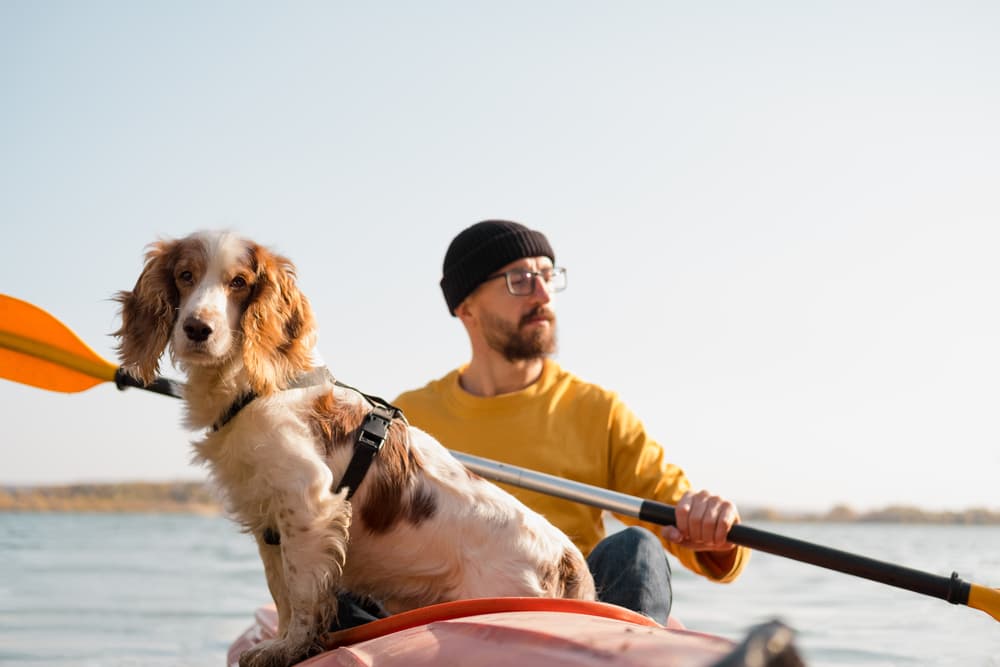
Before you head out paddling with your pup, it’s important to navigate prepping and training. Here are some tips on what you need to know about teaching your dog to kayak.
Make sure your dog is a good fit for kayaking. Marissa Sunny, supervisor, lifesaving and care at Best Friends Animal Society recommends kayaking for a dog that likes water and feels comfortable being on unstable surfaces.
“A confident dog who doesn’t mind stairs, new surfaces, and enjoys the beach would be a good candidate for trying kayaking,” says Sunny. If you have a dog that’s afraid of the water, or has trouble swimming, or has bad balance, she is not a candidate for kayaking. If she falls in, she could panic even more and make things worse.
Ensure your dog knows how to swim. Furthermore, Sunny highly recommends that the dog “knows how to swim before going kayaking to be as safe as possible”. It’s important to always put a life vest on your dog, no matter how good of a swimmer she is.
Brush up on your own skills. It’s only recommended that you try kayaking with a dog if you are already skilled and experienced at navigating a kayak with ease. If you are a novice kayaker, it’s important to take lessons and gain confidence on the water before bringing your dog along.
Practice on solid ground before hitting the water. It’s recommended to start training your dog to sit and stay in the kayak while you’re on solid ground before taking your pup for a paddle on a river, lake, or stream. Start with short training sessions and use positive reinforcement to get your dog comfortable in a kayak. You can gradually work up to longer sessions and sessions where your dog is wearing a life jacket.
How to Choose the Right Dog Kayak: Things to Consider
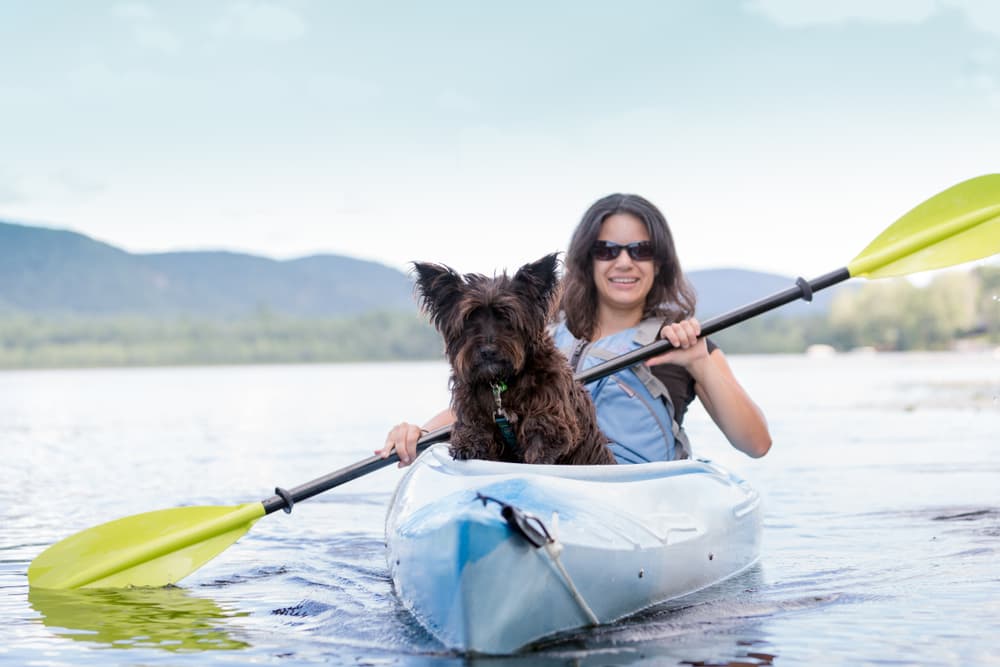
Choosing the right kayak for your outing with your dog can be challenging. There are so many options on the market and choosing between hardshell and inflatable, sit-on-top and sit-in, tandem or one-person kayaks can feel overwhelming.
This is why we’ve researched and put together this list of best kayaks out there for fun on the water for your pets.
Types of Kayaks for Dogs
Keep in mind that there aren’t specific “dog-friendly” kayaks. Any recreational kayak designed for the casual paddler can be used to bring your dog on the water, but here’s a breakdown of different types of kayaks and how they may function for bringing a dog along.
Sit-on-top: A sit-on-top kayak has an open cockpit and provides more space for your pet. The open deck is ideal for larger dogs as it gives them more room to move around, and can act as a jumping off point for dogs that like to swim.
Tandem: A tandem kayak is a two-person kayak, and this will give your pooch extra space for relaxing on the water. If you have a smaller dog or one that likes staying close, a tandem kayak may not be the best option.
Inflatable: Inflatable kayaks on the market today can be durable and safe for kayaking with pets, and the chance of it getting torn up or punctured by the dog’s nails are slim. Still, make sure to read reviews about durability before purchasing. Inflatable kayaks may not be the best option if your dog is a heavy chewer or likes to dig.
Other Kayak Features to Keep in Mind
Stability: Typically, sit-on-top fishing kayaks and inflatable kayaks tend to be more stable and are considered dog-friendly kayaks as they are wider and have higher weight capacities. But regardless of the type of kayak you are venturing out on, make sure to purchase one that’s large enough to carry the combined weight of you, your dog and gear.
Space: A single-person, sit-in kayak may not have enough space for you and your pet to ride comfortably. If you have a small dog, you may be able to get away with bringing her on a single-person kayak.
Kayaking with Dogs: Expert Tips
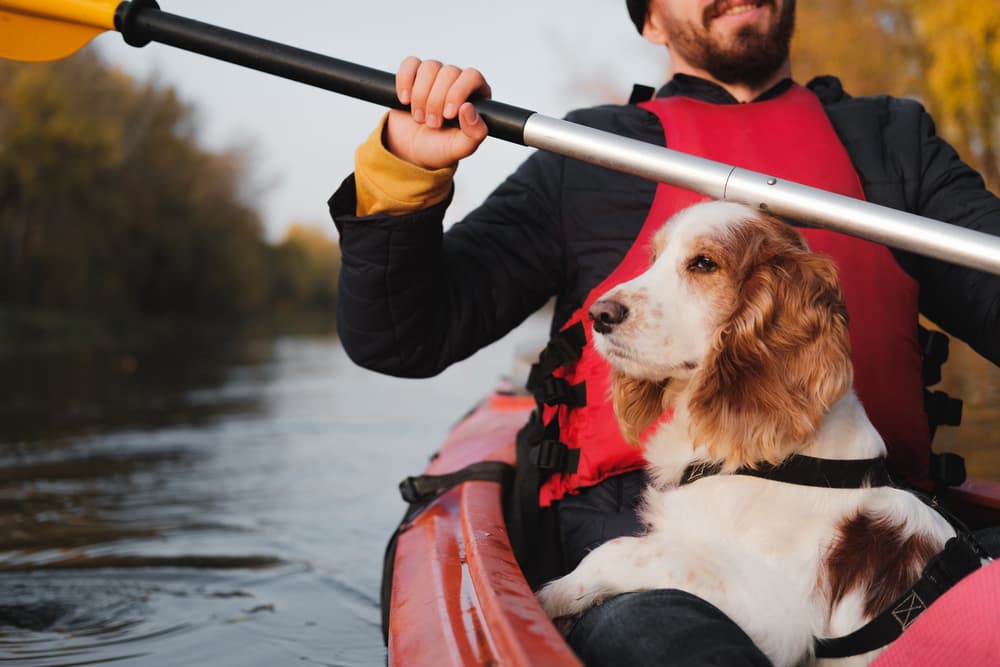
Kayaking can be an enjoyable experience for your dog if it’s done right. It is important to know whether your dog is a fit for kayaking. Once that’s determined, invest some time in training your dog to like the watercraft, whether it’s an inflatable kayak or a hardshell kayak, and get them used to plastic or inflatable slippery surfaces. Below are some tips and suggestions from experts.
Start Training on Land
Devene Godau, a certified fear-free dog trainer based in Detroit, Michigan, recommends putting the kayak on dry ground first and making favorable associations with it for the dog. “Feed them in the kayak. Encourage them to jump on to the kayak,” she recommends.
Godau uses the clicker training method, and when the dog goes and sits in the position or spot she wants her to, she will reward. Once the dog is comfortable with the position, she adds gentle movement. For larger dogs, Godau trains them to sit still, while still on land, and then takes them out on shallow water so she can help if they end up tipping the kayak. This can be done by teaching your pup ‘come’ and ‘stay’ commands. Training these commands will also help to control distractions on the water, whether it be other boaters, ducks, floating sticks, etc.
“There are many dogs that are just natural kayakers, so this may seem excessive, but you can never be too careful,” says Godau. “Conditioning them helps to insure your dog will have fun.”
Getting Started on the Water
After initial training on land, take the kayak to the shore of a lake. Lakes are always easier to start with, as the current is calmer, says Godau. Then, she recommends letting the dog get used to the feel of the water hitting the kayak in a shallow area, near the shore.
“If they jump out, they can feel the ground.” If the dog does not seem comfortable, do not push them. It’s much easier to coax a relaxed dog to get back in the vessel than a panicked dog.
To get in the kayak, go to a shallow entry point and have your kayak half in/half out of the water. Then cue the dog to get in first, and then slide in behind them. Enlist the help of a friend if you need to make this process a bit easier. Before you start paddling, be sure that your dog is comfortably laying down, otherwise the sudden jolt of launching could startle her.
If you are practicing on a lake that allows for boats and other watercrafts, make sure to go out on a calm day to prevent distractions or wakes that could make training more difficult.
Choose a Good Position for Your Pup
No matter what type of kayak you are using, identify a spot for your dog, so they won’t interfere with the paddling. Where the dog sits in the kayak will depend on the dog’s size and type of kayak. Dogs can comfortably lie down on a sit-on kayak. Add a yoga mat or marine traction tape in the areas your dog is drawn to, so they stay stable while you are paddling. A sit-in kayak is curved for the comfort of humans, but not dogs. So, a yoga mat, towel or a makeshift water-proof dog bed can provide added comfort.
Be Stringent About Safety
“Dogs should always wear a life jacket while kayaking, even if they are a strong swimmer,” says Sunny. There is always a risk that the kayak could tip over or the dog jumps out far from shore and needs the extra help to swim to safety. It’s also key to not tie the dog’s leash to the kayak as it could get caught under the vessel or wrap around the dog’s neck if it tips over.
Godau recommends putting a Personal Flotation Device (PFD) vest that has a floatation device at the chin, so “if they are having a hard time staying up in the water, it will help them keep their head above water.” Similar to getting the dog used to the kayak on land, it’s best to get her used to wearing a life vest before hitting the water. “I put it on, and feed them dinner. Or give them treats. Or play ball. Whatever they love most,” says Godau.
In the event the kayak tips over, Godau suggests getting the dog on the kayak first by grabbing the handle on the back of the vest, which would then free up your arms to pull yourself in.
Monitor Water and Weather Conditions
If the water you are kayaking on has been tested for blue-green algae, avoid going out. Algae is more common in stagnant water. “That is my biggest health concern when taking the dogs out on the water because I have heard some heart breaking stories from owners that have lost dogs quickly from ingesting the blooms,” says Godau.
Avoid really hot days. If temperatures climb over 90 degrees, stay home until the sun goes down. If you are already on the water and your dog experiences heat stress, constantly pour or splash water on their feet and tummy, recommend Godau. Avoid using really cold water as it can cause shock.
Even on comfortable days, it’s best to provide some sort of shade for the dog and plenty of fresh water, so she can relax on the ride. Just like humans, dogs can get sunburned, too, so pack dog-friendly sunblock.



